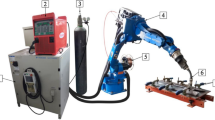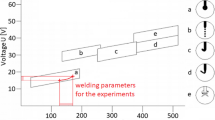Abstract
Welding-induced distortion is a major concern in the assembly of automotive components. Finite element-based welding simulation plays an important role in predicting the distortion so that the welding process can be modified during the design phase to alleviate the distortion experienced in production. In this work, gas metal arc welding (GMAW)-induced distortion was modeled and simulated for two HSLA steel welding cases as commonly seen in automotive body assembly. First, a “straight-clamshell” GMAW process was simulated and then validated against the measured temperatures, displacements, clam** forces due to thermal stresses at clam** positions, and weld penetration under various welding conditions. The numerical model captured the different strategies of welding directly versus tacking the parts first, resulting in 8 mm versus less than 2.0 mm of maximum distortion respectively. By overlaying resulting shapes from both simulation and laser scan measurement, it was confirmed that simulation can predict welding-induced distortion with sufficient accuracy. The simulation capability was further evaluated through a complete production case of truck rails welding. The same methodology was applied to compare simulation results (shape) with laser scan measurement data. Both simulation and test results confirm that welding distortion is greatly affected by boundary conditions, welding parameters, and welding sequence, all of which support simulation of the dimensional impact of welding in the manufacturing process design stage.











































Similar content being viewed by others
References
Ueda Y, Yamakawa T (1971) Analysis of thermal elastic-plastic stress and strain during welding by finite element method. Trans Jpn Weld Soc 2(2):186–196
Hibbit HD, Marcal PV (1973) A numerical, thermo-mechanical model for the welding and subsequent loading of a fabricated structure. Comput Struct 3:1145–1174
Lindgren LE (2001) Finite element modelling and simulation of welding – Part 1: Increased complexity. J Therm Stresses 24:141–192
Lindgren LE (2001) Finite element modelling and simulation of welding – Part 2: Improved material modelling. J Therm Stresses 24:195–231
Lindgren LE (2001) Finite element modelling and simulation of welding – Part 3: Efficiency and integration. J Therm Stresses 24:305–334
Michaleris P, Debiccari A (1997) Prediction of welding distortion. Wel Res Suppl 76:172–181
Michaleris P, Zhang L, Bhide SR, Marugabandhu P (2006) Evaluation of 2D, 3D and applied plastic strain methods for predicting buckling welding distortion and residual stress. Sci Technol Weld Join 11(6):707–716
Tsai CL, Park SC, Cheng WT (1999) “Welding distortion of a thin-plate panel structure. Weld Jo 78:156-s
Yang YP, Dong P (2012) Buckling distortions and mitigation techniques for thin-section structures. J Mater Eng Perform 21(2):153–160
Huang H, Murakawa H (2013) Development of dynamic mesh refining method for large scale thermal and mechanical analysis in welding and line heating. Trans Jwri 42(1):63–70
Huang H, Ma N, Murakawa H, Feng Z (2019) A dual-mesh method for efficient thermal stress analysis of large-scale welded structures. Int J Adv Manuf Technol 103:769–780
Lindgren L, Karlsson L (1988) “Deformation and stresses in welding of shell structures,.” Int J Numer Meth Eng 25:635–655
Samanta A, Mukhopadhyay M (1999) Finite element large deflection static analysis of shallow and deep stiffened shells. Finite Elem Anal Des 33:187–208
MacNeal RH (1998) Perspective on finite elements for shell analysis. Finite Elem Anal Des 30:175–186
Fahlström K, Andersson O, Todal U, Melander A (2005) “Minimization of distortions during laser welding of ultra-high strength steel. J Laser Appl 27:S29011
Tchoumi T, Peyraut F, Bolot R (2016) Influence of the welding speed on the distortion of thin stainless steel plates – numerical and experimental investigations in the framework of the food industry machines. J Mater Process Technol 229:216–229
Chen Z, Chen Z, Shenoi RA (2015) Influence of welding sequence on welding deformation and residual stress of a stiffened plate structure. Ocean Eng 106:271–280
Schenk T, Richardson IM, Kraska M, Ohnimus S (2009) Influence of clam** on distortion of welded S355 T-joints. Sci Technol Weld Joining 14(4):369–375
Schenk T, Richardson IM, Kraska M, Ohnimus S (2009) A study on the influence of clam** on welding distortion. Comput Mater Sci 45(4):999–1005
Ma N, Huang H, Murakawa H (2015) Effect of jig constraint position and pitch on welding deformation. J Mater Process Technol 221:154–162
Zhang C, Li S, Sun J, Wang Y, Deng D (2019) “Controlling angular distortion in high strength low alloy steel thick-plate T-joints. J Mater Process Technol 267:257–267
Lou M, Li Y, Cai W, Wang H, Carlson BE, Huang J, Poss MG (2020) Simulation of laser brazing of sheet panels and parametric studies of thermally-induced distortion reduction. Sme J Manuf Process 60:1–10
Thater R, Wiethop P, Rethmeier M (2015) Welding simulation in car body construction: virtual welding sequence planning for remote laser applications. Laser Tech J 12(2):33–37
Perret W, Schwenk C, Ethmeier MR, Raphael TR, Alber U (2011) Case study for welding simulation in the automotive industry. Weld World 55:89–98
Nateghi E, Volukola AG (2016) Experimental and numerical investigation into effect of weld configuration geometry on distribution of residual stress and temperature in the welded parts of stainless steel. Int J Adv Manuf Technol 87:2391–2404
Islam M, Bujik A, Rais-Rohani M, Motoyama K (2014) Simulation-based numerical optimization of arc welding process for reduced distortion in welded structures. Finite Elem Anal Des 84:54–64
Alro Steel “A1011 HSLA Steel Sheet”. www.alro.com/divsteel/metals_gridpt.aspx?gp=0057. Accessed 1 Sept 2021
Elsener B, Neubauer I, Khazan P, Gatzen M (2018) Simufact welding theoretical background manual. Simufact Engineering GmbH
Goldak J, Chakravarti A, Bibby M (1984) A new finite element model for welding heat sources. Metall Trans B 15(2):299–305
Acknowledgements
The authors gratefully acknowledge Andrew Galant and Nathan Thompson for their assistance in instrumentation for the welding experiments and Aaron Steele for providing software and hardware support with the laser scanner and point cloud processing.
Author information
Authors and Affiliations
Corresponding author
Ethics declarations
Conflict of interest
The authors declare no competing interests.
Additional information
Publisher's note
Springer Nature remains neutral with regard to jurisdictional claims in published maps and institutional affiliations.
Recommended for publication by Commission XII - Arc Welding Processes and Production Systems.
Rights and permissions
Springer Nature or its licensor (e.g. a society or other partner) holds exclusive rights to this article under a publishing agreement with the author(s) or other rightsholder(s); author self-archiving of the accepted manuscript version of this article is solely governed by the terms of such publishing agreement and applicable law.
About this article
Cite this article
Cai, W., Saez, M., Spicer, P. et al. Distortion simulation of gas metal arc welding (GMAW) processes for automotive body assembly. Weld World 67, 109–139 (2023). https://doi.org/10.1007/s40194-022-01369-3
Received:
Accepted:
Published:
Issue Date:
DOI: https://doi.org/10.1007/s40194-022-01369-3




